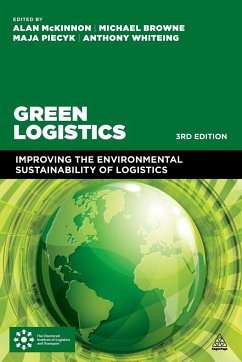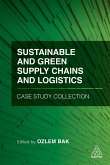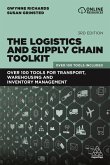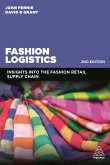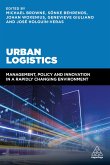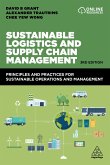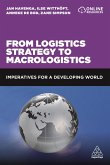Green Logistics
Improving the Environmental Sustainability of Logistics
Herausgeber: Mckinnon, Alan; Whiteing, Anthony; Browne, Michael
Green Logistics
Improving the Environmental Sustainability of Logistics
Herausgeber: Mckinnon, Alan; Whiteing, Anthony; Browne, Michael
- Broschiertes Buch
- Merkliste
- Auf die Merkliste
- Bewerten Bewerten
- Teilen
- Produkt teilen
- Produkterinnerung
- Produkterinnerung
Understand the eco-impacts of logistics and learn how to handle them effectively by achieving sustainable balance between economic, environmental, and social objectives.
Andere Kunden interessierten sich auch für
![Sustainable and Green Supply Chains and Logistics Case Study Collection Sustainable and Green Supply Chains and Logistics Case Study Collection]() Dr Ozlem BakSustainable and Green Supply Chains and Logistics Case Study Collection228,99 €
Dr Ozlem BakSustainable and Green Supply Chains and Logistics Case Study Collection228,99 €![Capitalism Created the Climate Crisis and Capitalism Will Solve It Capitalism Created the Climate Crisis and Capitalism Will Solve It]() Kentaro KawamoriCapitalism Created the Climate Crisis and Capitalism Will Solve It25,99 €
Kentaro KawamoriCapitalism Created the Climate Crisis and Capitalism Will Solve It25,99 €![The Logistics and Supply Chain Toolkit The Logistics and Supply Chain Toolkit]() Gwynne RichardsThe Logistics and Supply Chain Toolkit68,99 €
Gwynne RichardsThe Logistics and Supply Chain Toolkit68,99 €![Fashion Logistics Fashion Logistics]() John FernieFashion Logistics72,99 €
John FernieFashion Logistics72,99 €![Urban Logistics Urban Logistics]() Urban Logistics88,99 €
Urban Logistics88,99 €![Sustainable Logistics and Supply Chain Management Sustainable Logistics and Supply Chain Management]() David B. GrantSustainable Logistics and Supply Chain Management55,99 €
David B. GrantSustainable Logistics and Supply Chain Management55,99 €![From Logistics Strategy to Macrologistics From Logistics Strategy to Macrologistics]() Professor Jan HavengaFrom Logistics Strategy to Macrologistics78,99 €
Professor Jan HavengaFrom Logistics Strategy to Macrologistics78,99 €-
-
-
Understand the eco-impacts of logistics and learn how to handle them effectively by achieving sustainable balance between economic, environmental, and social objectives.
Hinweis: Dieser Artikel kann nur an eine deutsche Lieferadresse ausgeliefert werden.
Hinweis: Dieser Artikel kann nur an eine deutsche Lieferadresse ausgeliefert werden.
Produktdetails
- Produktdetails
- Verlag: Kogan Page Ltd
- 3 Revised edition
- Seitenzahl: 450
- Erscheinungstermin: 1. Februar 2015
- Englisch
- Abmessung: 234mm x 156mm x 25mm
- Gewicht: 698g
- ISBN-13: 9780749471859
- ISBN-10: 0749471859
- Artikelnr.: 40788430
- Herstellerkennzeichnung
- Libri GmbH
- Europaallee 1
- 36244 Bad Hersfeld
- gpsr@libri.de
- Verlag: Kogan Page Ltd
- 3 Revised edition
- Seitenzahl: 450
- Erscheinungstermin: 1. Februar 2015
- Englisch
- Abmessung: 234mm x 156mm x 25mm
- Gewicht: 698g
- ISBN-13: 9780749471859
- ISBN-10: 0749471859
- Artikelnr.: 40788430
- Herstellerkennzeichnung
- Libri GmbH
- Europaallee 1
- 36244 Bad Hersfeld
- gpsr@libri.de
Alan McKinnon is Professor and Head of Logistics at Kühne Logistics University, Germany. Michael Browne is Professor of Logistics at the University of Westminster, UK. Anthony Whiteing teaches at the Institute for Transport Studies at the University of Leeds, UK. Maja Piecyk is Associate Professor in Logistics at Heriot-Watt University, UK. Contributors: Julian Allen, Senior Research Fellow in the Planning and Transport Department at the University of Westminster Peter Baker, Visiting Fellow at Cranfield School of Management Maria Björklund, Associate Professor of Logistics Management in the Department of Management and Engineering at Linköping University Daniel Black, teaches Management Science in the Business School at the University of Edinburgh Tom Cherrett, Associate Professor of Logistics at the Transportation Research Group, University of Southampton Sharon Cullinane, Visiting Fellow at the School of Business, Economics and Law at the University of Gothenburg Julia Edwards, former Research Associate at the Logistics Research Centre in the School of Management and Languages at Heriot-Watt University Richard Eglese, Professor of Operational Research in the Department of Management Science at Lancaster University Management School Tara Garnett, Environmental Change Institute at the University of Oxford Irina Harris, teaches Logistics and Operations Modelling within the Logistics and Operations Management Section at the Cardiff Business School, Cardiff University Adrian Hickford, Senior Research Assistant at the Transportation Research Group at the University of Southampton José Holguín-Veras, WH Hart Professor of Civil and Environmental Engineering at the Rensselaer Polytechnic Institute Jacques Leonardi, Senior Research Fellow in the Department of Planning and Transport, University of Westminster Clive Marchant, former Senior Teaching Fellow at Heriot-Watt University Sarah Maynard, former researcher at the Transportation Research Group (TRG), University of Southampton Fraser McLeod, Research Fellow with the Transportation Research Group, University of Southampton Christine Mumford, Reader in Computer Science and Informatics at Cardiff University Mohamed Naim, Professor in Logistics and Operations Management and Associate Dean at Cardiff Business School Andrew Potter, Reader in Transport and Logistics at Cardiff University Vasco Sanchez-Rodrigues, teaches Logistics and Operations Management at Cardiff Business School Yingli Wang, teaches Logistics and Operations Management at Cardiff Business School. Allan Woodburn, teaches Freight and Logistics in the Planning and Transport Department at the University of Westminster
List of Figures List of Tables Contributor biographies
Part One Assessing the environmental effects of logistics
01 Environmental sustainability: A new priority for logistics managers Alan
McKinnon Introduction A brief history of green logistics research Green
logistics: Rhetoric and reality Future scenarios A model for green
logistics research Outline of the book References
02 Assessing the external impacts of freight transport Maja Piecyk, Sharon
Cullinane and Julia Edwards Introduction External impacts Environmental
standards Measuring the environmental impact of freight transport
References
03 Carbon auditing of companies, supply chains and products Maja Piecyk
Introduction Guidelines for carbon footprinting The carbon footprinting
process Success factors in carbon footprinting Case study: Carbon auditing
of road freight transport operations in the UK Next steps Conclusions Note
References
04 Evaluating and internalizing the environmental costs of logistics Maja
Piecyk, Alan McKinnon and Julian Allen Introduction Arguments for and
against the internalization of environmental costs Monetary valuation of
environmental costs Goods vehicle external costs: Case studies Conclusions
Note References
Part Two Strategic perspective
05 Green logistics, sustainable development and corporate social
responsibility Maja Piecyk and Maria Björklund Introduction Sustainable
development and sustainable distribution Corporate social responsibility
(CSR) Stakeholders in CSR CSR reporting standards CSR and the logistics
function Case study: CSR reporting in the logistics industry Conclusions
Notes References
06 Restructuring road freight networks within supply chains Irina Harris,
Vasco Sanchez-Rodrigues, Mohamed Naim and Christine Mumford Introduction
Traditional network design Green network design Uncertainty in transport
and supply chains Uncertainty mitigation approaches in road freight
transport networks Gaps in our understanding and priorities for research
Consequences and conclusions References
07 Transferring freight to 'greener' transport modes Allan Woodburn and
Anthony Whiteing Background Characteristics of the main freight transport
modes Environmental impacts of the main freight transport modes Case study:
Container train load factors The policy framework Initiatives to promote
freight modal shift for environmental benefit Good practice in achieving
modal shift to rail and water Conclusions References
08 Development of greener vehicles, aircraft and ships Alan McKinnon,
Julian Allen and Allan Woodburn Introduction Road freight Rail freight Air
freight Shipping Conclusions Notes References
09 Reducing the environmental impact of warehousing Peter Baker and Clive
Marchant Introduction Scale of the environmental impact Increasing resource
intensity Framework for assessing the environmental impact of warehouses
Ways of reducing the environmental impact Conclusion References
Part Three Operational perspective
10 Optimizing the routeing of vehicles Richard Eglese and Daniel Black
Introduction Vehicle routeing problems Problem varieties Environmental
impact Conclusions References
11 Opportunities for improving vehicle utilization Alan McKinnon
Introduction Measuring vehicle utilization Factors affecting the
utilization of truck capacity Conclusion References
12 Increasing fuel efficiency in the road freight sector Alan McKinnon
Introduction Fuel efficiency of new trucks Vehicle design: Aerodynamic
profiling Reducing the vehicle tare weight Vehicle purchase decision
Vehicle maintenance Increasing the fuel efficiency of trucking operations
Benchmarking the fuel efficiency of trucks More fuel-efficient driving
Fleet management Conclusions References
13 Alternative fuels and freight vehicles: Status, costs and benefits, and
growth Jacques Leonardi, Sharon Cullinane and Julia Edwards Introduction
State of development of alternative fuels for freight vehicles Current use
of alternative fuels for freight vehicles Costs and benefits Growth
potential References
Part Four Key issues
14 Sustainability strategies for city logistics Julian Allen, Michael
Browne and José Holguín-Veras Introduction Urban freight research and
policy making Efficiency problems in urban freight transport Urban freight
transport initiatives Urban consolidation centres Collaboration between the
public and private sectors Environmental zones Conclusions Notes References
15 E-business, e-logistics and the environment Alan McKinnon, Yingli Wang,
Andrew Potter and Julia Edwards Introduction Business-to-business (B2B)
Business-to-consumer (B2C) References
16 Reverse logistics for the management of waste Tom Cherrett, Sarah
Maynard, Fraser McLeod and Adrian Hickford Introduction Waste management in
the context of reverse logistics The impact of waste treatment legislation
Reuse, refurbishment markets and take-back schemes Managing waste as part
of a sustainable reverse process Conclusions References
17 The food miles debate: Is shorter better? Tara Garnett Introduction
Transport and GHGs: Is further worse? Transport, the second-order impacts
and the implications for GHGs Local vs global and the self-sufficiency
question Notes References
Part Five Implications for public policy and the future of supply chains
18 The role of government in promoting green logistics Alan McKinnon
Introduction Objectives of public policy on sustainable logistics Policy
measures Reducing freight transport intensity Shifting freight to greener
transport modes Improving vehicle utilization Increasing energy efficiency
Switching to less polluting energy sources Government-supported advisory,
best practice and accreditation programmes Conclusion Note References
Postscript 1: Distribution by drone Alan McKinnon 1 Introduction 2 System
specification 3 Applications 4 Operational feasibility 5 Environmental
impact References
Postscript 2: 3D printing Alan McKinnon and Anthony Whiteing References
Postscript 3: Physical (logistics) internet (π) Maja Piecyk Notes
References
Postscript 4: Peak freight: could it ever happen? Michael Browne Note
References
Index
Part One Assessing the environmental effects of logistics
01 Environmental sustainability: A new priority for logistics managers Alan
McKinnon Introduction A brief history of green logistics research Green
logistics: Rhetoric and reality Future scenarios A model for green
logistics research Outline of the book References
02 Assessing the external impacts of freight transport Maja Piecyk, Sharon
Cullinane and Julia Edwards Introduction External impacts Environmental
standards Measuring the environmental impact of freight transport
References
03 Carbon auditing of companies, supply chains and products Maja Piecyk
Introduction Guidelines for carbon footprinting The carbon footprinting
process Success factors in carbon footprinting Case study: Carbon auditing
of road freight transport operations in the UK Next steps Conclusions Note
References
04 Evaluating and internalizing the environmental costs of logistics Maja
Piecyk, Alan McKinnon and Julian Allen Introduction Arguments for and
against the internalization of environmental costs Monetary valuation of
environmental costs Goods vehicle external costs: Case studies Conclusions
Note References
Part Two Strategic perspective
05 Green logistics, sustainable development and corporate social
responsibility Maja Piecyk and Maria Björklund Introduction Sustainable
development and sustainable distribution Corporate social responsibility
(CSR) Stakeholders in CSR CSR reporting standards CSR and the logistics
function Case study: CSR reporting in the logistics industry Conclusions
Notes References
06 Restructuring road freight networks within supply chains Irina Harris,
Vasco Sanchez-Rodrigues, Mohamed Naim and Christine Mumford Introduction
Traditional network design Green network design Uncertainty in transport
and supply chains Uncertainty mitigation approaches in road freight
transport networks Gaps in our understanding and priorities for research
Consequences and conclusions References
07 Transferring freight to 'greener' transport modes Allan Woodburn and
Anthony Whiteing Background Characteristics of the main freight transport
modes Environmental impacts of the main freight transport modes Case study:
Container train load factors The policy framework Initiatives to promote
freight modal shift for environmental benefit Good practice in achieving
modal shift to rail and water Conclusions References
08 Development of greener vehicles, aircraft and ships Alan McKinnon,
Julian Allen and Allan Woodburn Introduction Road freight Rail freight Air
freight Shipping Conclusions Notes References
09 Reducing the environmental impact of warehousing Peter Baker and Clive
Marchant Introduction Scale of the environmental impact Increasing resource
intensity Framework for assessing the environmental impact of warehouses
Ways of reducing the environmental impact Conclusion References
Part Three Operational perspective
10 Optimizing the routeing of vehicles Richard Eglese and Daniel Black
Introduction Vehicle routeing problems Problem varieties Environmental
impact Conclusions References
11 Opportunities for improving vehicle utilization Alan McKinnon
Introduction Measuring vehicle utilization Factors affecting the
utilization of truck capacity Conclusion References
12 Increasing fuel efficiency in the road freight sector Alan McKinnon
Introduction Fuel efficiency of new trucks Vehicle design: Aerodynamic
profiling Reducing the vehicle tare weight Vehicle purchase decision
Vehicle maintenance Increasing the fuel efficiency of trucking operations
Benchmarking the fuel efficiency of trucks More fuel-efficient driving
Fleet management Conclusions References
13 Alternative fuels and freight vehicles: Status, costs and benefits, and
growth Jacques Leonardi, Sharon Cullinane and Julia Edwards Introduction
State of development of alternative fuels for freight vehicles Current use
of alternative fuels for freight vehicles Costs and benefits Growth
potential References
Part Four Key issues
14 Sustainability strategies for city logistics Julian Allen, Michael
Browne and José Holguín-Veras Introduction Urban freight research and
policy making Efficiency problems in urban freight transport Urban freight
transport initiatives Urban consolidation centres Collaboration between the
public and private sectors Environmental zones Conclusions Notes References
15 E-business, e-logistics and the environment Alan McKinnon, Yingli Wang,
Andrew Potter and Julia Edwards Introduction Business-to-business (B2B)
Business-to-consumer (B2C) References
16 Reverse logistics for the management of waste Tom Cherrett, Sarah
Maynard, Fraser McLeod and Adrian Hickford Introduction Waste management in
the context of reverse logistics The impact of waste treatment legislation
Reuse, refurbishment markets and take-back schemes Managing waste as part
of a sustainable reverse process Conclusions References
17 The food miles debate: Is shorter better? Tara Garnett Introduction
Transport and GHGs: Is further worse? Transport, the second-order impacts
and the implications for GHGs Local vs global and the self-sufficiency
question Notes References
Part Five Implications for public policy and the future of supply chains
18 The role of government in promoting green logistics Alan McKinnon
Introduction Objectives of public policy on sustainable logistics Policy
measures Reducing freight transport intensity Shifting freight to greener
transport modes Improving vehicle utilization Increasing energy efficiency
Switching to less polluting energy sources Government-supported advisory,
best practice and accreditation programmes Conclusion Note References
Postscript 1: Distribution by drone Alan McKinnon 1 Introduction 2 System
specification 3 Applications 4 Operational feasibility 5 Environmental
impact References
Postscript 2: 3D printing Alan McKinnon and Anthony Whiteing References
Postscript 3: Physical (logistics) internet (π) Maja Piecyk Notes
References
Postscript 4: Peak freight: could it ever happen? Michael Browne Note
References
Index
List of Figures List of Tables Contributor biographies
Part One Assessing the environmental effects of logistics
01 Environmental sustainability: A new priority for logistics managers Alan
McKinnon Introduction A brief history of green logistics research Green
logistics: Rhetoric and reality Future scenarios A model for green
logistics research Outline of the book References
02 Assessing the external impacts of freight transport Maja Piecyk, Sharon
Cullinane and Julia Edwards Introduction External impacts Environmental
standards Measuring the environmental impact of freight transport
References
03 Carbon auditing of companies, supply chains and products Maja Piecyk
Introduction Guidelines for carbon footprinting The carbon footprinting
process Success factors in carbon footprinting Case study: Carbon auditing
of road freight transport operations in the UK Next steps Conclusions Note
References
04 Evaluating and internalizing the environmental costs of logistics Maja
Piecyk, Alan McKinnon and Julian Allen Introduction Arguments for and
against the internalization of environmental costs Monetary valuation of
environmental costs Goods vehicle external costs: Case studies Conclusions
Note References
Part Two Strategic perspective
05 Green logistics, sustainable development and corporate social
responsibility Maja Piecyk and Maria Björklund Introduction Sustainable
development and sustainable distribution Corporate social responsibility
(CSR) Stakeholders in CSR CSR reporting standards CSR and the logistics
function Case study: CSR reporting in the logistics industry Conclusions
Notes References
06 Restructuring road freight networks within supply chains Irina Harris,
Vasco Sanchez-Rodrigues, Mohamed Naim and Christine Mumford Introduction
Traditional network design Green network design Uncertainty in transport
and supply chains Uncertainty mitigation approaches in road freight
transport networks Gaps in our understanding and priorities for research
Consequences and conclusions References
07 Transferring freight to 'greener' transport modes Allan Woodburn and
Anthony Whiteing Background Characteristics of the main freight transport
modes Environmental impacts of the main freight transport modes Case study:
Container train load factors The policy framework Initiatives to promote
freight modal shift for environmental benefit Good practice in achieving
modal shift to rail and water Conclusions References
08 Development of greener vehicles, aircraft and ships Alan McKinnon,
Julian Allen and Allan Woodburn Introduction Road freight Rail freight Air
freight Shipping Conclusions Notes References
09 Reducing the environmental impact of warehousing Peter Baker and Clive
Marchant Introduction Scale of the environmental impact Increasing resource
intensity Framework for assessing the environmental impact of warehouses
Ways of reducing the environmental impact Conclusion References
Part Three Operational perspective
10 Optimizing the routeing of vehicles Richard Eglese and Daniel Black
Introduction Vehicle routeing problems Problem varieties Environmental
impact Conclusions References
11 Opportunities for improving vehicle utilization Alan McKinnon
Introduction Measuring vehicle utilization Factors affecting the
utilization of truck capacity Conclusion References
12 Increasing fuel efficiency in the road freight sector Alan McKinnon
Introduction Fuel efficiency of new trucks Vehicle design: Aerodynamic
profiling Reducing the vehicle tare weight Vehicle purchase decision
Vehicle maintenance Increasing the fuel efficiency of trucking operations
Benchmarking the fuel efficiency of trucks More fuel-efficient driving
Fleet management Conclusions References
13 Alternative fuels and freight vehicles: Status, costs and benefits, and
growth Jacques Leonardi, Sharon Cullinane and Julia Edwards Introduction
State of development of alternative fuels for freight vehicles Current use
of alternative fuels for freight vehicles Costs and benefits Growth
potential References
Part Four Key issues
14 Sustainability strategies for city logistics Julian Allen, Michael
Browne and José Holguín-Veras Introduction Urban freight research and
policy making Efficiency problems in urban freight transport Urban freight
transport initiatives Urban consolidation centres Collaboration between the
public and private sectors Environmental zones Conclusions Notes References
15 E-business, e-logistics and the environment Alan McKinnon, Yingli Wang,
Andrew Potter and Julia Edwards Introduction Business-to-business (B2B)
Business-to-consumer (B2C) References
16 Reverse logistics for the management of waste Tom Cherrett, Sarah
Maynard, Fraser McLeod and Adrian Hickford Introduction Waste management in
the context of reverse logistics The impact of waste treatment legislation
Reuse, refurbishment markets and take-back schemes Managing waste as part
of a sustainable reverse process Conclusions References
17 The food miles debate: Is shorter better? Tara Garnett Introduction
Transport and GHGs: Is further worse? Transport, the second-order impacts
and the implications for GHGs Local vs global and the self-sufficiency
question Notes References
Part Five Implications for public policy and the future of supply chains
18 The role of government in promoting green logistics Alan McKinnon
Introduction Objectives of public policy on sustainable logistics Policy
measures Reducing freight transport intensity Shifting freight to greener
transport modes Improving vehicle utilization Increasing energy efficiency
Switching to less polluting energy sources Government-supported advisory,
best practice and accreditation programmes Conclusion Note References
Postscript 1: Distribution by drone Alan McKinnon 1 Introduction 2 System
specification 3 Applications 4 Operational feasibility 5 Environmental
impact References
Postscript 2: 3D printing Alan McKinnon and Anthony Whiteing References
Postscript 3: Physical (logistics) internet (π) Maja Piecyk Notes
References
Postscript 4: Peak freight: could it ever happen? Michael Browne Note
References
Index
Part One Assessing the environmental effects of logistics
01 Environmental sustainability: A new priority for logistics managers Alan
McKinnon Introduction A brief history of green logistics research Green
logistics: Rhetoric and reality Future scenarios A model for green
logistics research Outline of the book References
02 Assessing the external impacts of freight transport Maja Piecyk, Sharon
Cullinane and Julia Edwards Introduction External impacts Environmental
standards Measuring the environmental impact of freight transport
References
03 Carbon auditing of companies, supply chains and products Maja Piecyk
Introduction Guidelines for carbon footprinting The carbon footprinting
process Success factors in carbon footprinting Case study: Carbon auditing
of road freight transport operations in the UK Next steps Conclusions Note
References
04 Evaluating and internalizing the environmental costs of logistics Maja
Piecyk, Alan McKinnon and Julian Allen Introduction Arguments for and
against the internalization of environmental costs Monetary valuation of
environmental costs Goods vehicle external costs: Case studies Conclusions
Note References
Part Two Strategic perspective
05 Green logistics, sustainable development and corporate social
responsibility Maja Piecyk and Maria Björklund Introduction Sustainable
development and sustainable distribution Corporate social responsibility
(CSR) Stakeholders in CSR CSR reporting standards CSR and the logistics
function Case study: CSR reporting in the logistics industry Conclusions
Notes References
06 Restructuring road freight networks within supply chains Irina Harris,
Vasco Sanchez-Rodrigues, Mohamed Naim and Christine Mumford Introduction
Traditional network design Green network design Uncertainty in transport
and supply chains Uncertainty mitigation approaches in road freight
transport networks Gaps in our understanding and priorities for research
Consequences and conclusions References
07 Transferring freight to 'greener' transport modes Allan Woodburn and
Anthony Whiteing Background Characteristics of the main freight transport
modes Environmental impacts of the main freight transport modes Case study:
Container train load factors The policy framework Initiatives to promote
freight modal shift for environmental benefit Good practice in achieving
modal shift to rail and water Conclusions References
08 Development of greener vehicles, aircraft and ships Alan McKinnon,
Julian Allen and Allan Woodburn Introduction Road freight Rail freight Air
freight Shipping Conclusions Notes References
09 Reducing the environmental impact of warehousing Peter Baker and Clive
Marchant Introduction Scale of the environmental impact Increasing resource
intensity Framework for assessing the environmental impact of warehouses
Ways of reducing the environmental impact Conclusion References
Part Three Operational perspective
10 Optimizing the routeing of vehicles Richard Eglese and Daniel Black
Introduction Vehicle routeing problems Problem varieties Environmental
impact Conclusions References
11 Opportunities for improving vehicle utilization Alan McKinnon
Introduction Measuring vehicle utilization Factors affecting the
utilization of truck capacity Conclusion References
12 Increasing fuel efficiency in the road freight sector Alan McKinnon
Introduction Fuel efficiency of new trucks Vehicle design: Aerodynamic
profiling Reducing the vehicle tare weight Vehicle purchase decision
Vehicle maintenance Increasing the fuel efficiency of trucking operations
Benchmarking the fuel efficiency of trucks More fuel-efficient driving
Fleet management Conclusions References
13 Alternative fuels and freight vehicles: Status, costs and benefits, and
growth Jacques Leonardi, Sharon Cullinane and Julia Edwards Introduction
State of development of alternative fuels for freight vehicles Current use
of alternative fuels for freight vehicles Costs and benefits Growth
potential References
Part Four Key issues
14 Sustainability strategies for city logistics Julian Allen, Michael
Browne and José Holguín-Veras Introduction Urban freight research and
policy making Efficiency problems in urban freight transport Urban freight
transport initiatives Urban consolidation centres Collaboration between the
public and private sectors Environmental zones Conclusions Notes References
15 E-business, e-logistics and the environment Alan McKinnon, Yingli Wang,
Andrew Potter and Julia Edwards Introduction Business-to-business (B2B)
Business-to-consumer (B2C) References
16 Reverse logistics for the management of waste Tom Cherrett, Sarah
Maynard, Fraser McLeod and Adrian Hickford Introduction Waste management in
the context of reverse logistics The impact of waste treatment legislation
Reuse, refurbishment markets and take-back schemes Managing waste as part
of a sustainable reverse process Conclusions References
17 The food miles debate: Is shorter better? Tara Garnett Introduction
Transport and GHGs: Is further worse? Transport, the second-order impacts
and the implications for GHGs Local vs global and the self-sufficiency
question Notes References
Part Five Implications for public policy and the future of supply chains
18 The role of government in promoting green logistics Alan McKinnon
Introduction Objectives of public policy on sustainable logistics Policy
measures Reducing freight transport intensity Shifting freight to greener
transport modes Improving vehicle utilization Increasing energy efficiency
Switching to less polluting energy sources Government-supported advisory,
best practice and accreditation programmes Conclusion Note References
Postscript 1: Distribution by drone Alan McKinnon 1 Introduction 2 System
specification 3 Applications 4 Operational feasibility 5 Environmental
impact References
Postscript 2: 3D printing Alan McKinnon and Anthony Whiteing References
Postscript 3: Physical (logistics) internet (π) Maja Piecyk Notes
References
Postscript 4: Peak freight: could it ever happen? Michael Browne Note
References
Index

